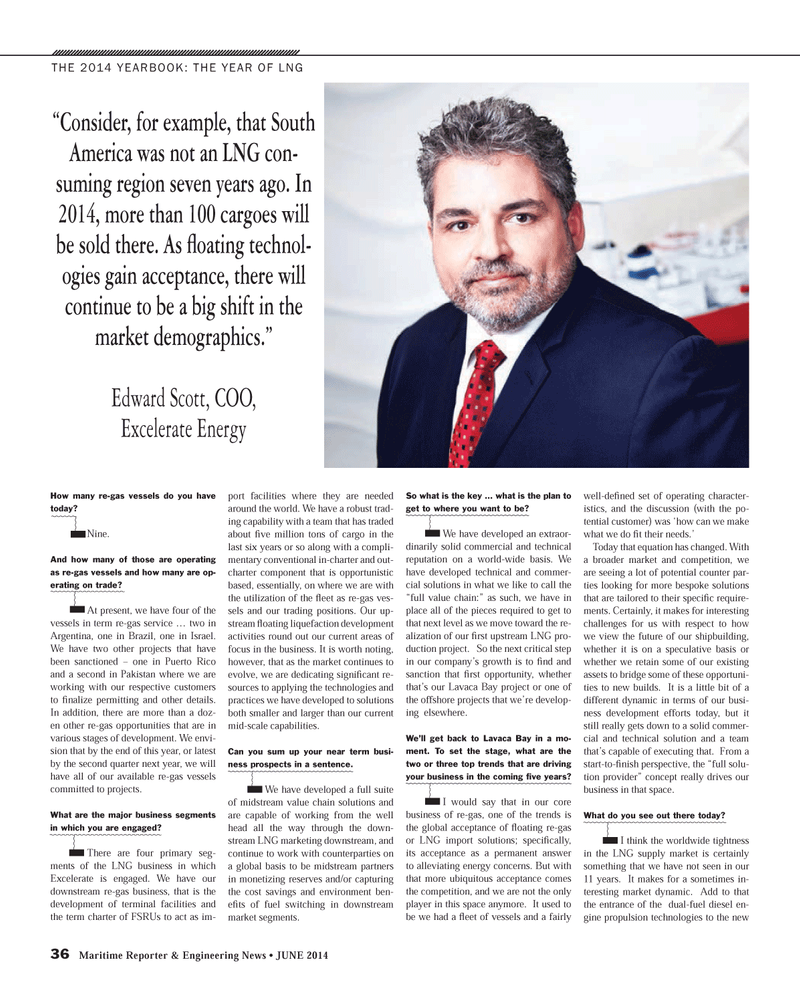
Page 36: of Maritime Reporter Magazine (June 2014)
Annual World Yearbook
Read this page in Pdf, Flash or Html5 edition of June 2014 Maritime Reporter Magazine
36 Maritime Reporter & Engineering News • JUNE 2014
How many re-gas vessels do you have today? Nine.
And how many of those are operating as re-gas vessels and how many are op- erating on trade? At present, we have four of the vessels in term re-gas service … two in
Argentina, one in Brazil, one in Israel.
We have two other projects that have been sanctioned – one in Puerto Rico and a second in Pakistan where we are working with our respective customers to ? nalize permitting and other details.
In addition, there are more than a doz- en other re-gas opportunities that are in various stages of development. We envi- sion that by the end of this year, or latest by the second quarter next year, we will have all of our available re-gas vessels committed to projects.
What are the major business segments in which you are engaged? There are four primary seg- ments of the LNG business in which
Excelerate is engaged. We have our downstream re-gas business, that is the development of terminal facilities and the term charter of FSRUs to act as im- port facilities where they are needed around the world. We have a robust trad- ing capability with a team that has traded about ? ve million tons of cargo in the last six years or so along with a compli- mentary conventional in-charter and out- charter component that is opportunistic based, essentially, on where we are with the utilization of the ? eet as re-gas ves- sels and our trading positions. Our up- stream ? oating liquefaction development activities round out our current areas of focus in the business. It is worth noting, however, that as the market continues to evolve, we are dedicating signi? cant re- sources to applying the technologies and practices we have developed to solutions both smaller and larger than our current mid-scale capabilities.
Can you sum up your near term busi- ness prospects in a sentence. We have developed a full suite of midstream value chain solutions and are capable of working from the well head all the way through the down- stream LNG marketing downstream, and continue to work with counterparties on a global basis to be midstream partners in monetizing reserves and/or capturing the cost savings and environment ben- e? ts of fuel switching in downstream market segments.
So what is the key … what is the plan to get to where you want to be? We have developed an extraor- dinarily solid commercial and technical reputation on a world-wide basis. We have developed technical and commer- cial solutions in what we like to call the “full value chain:” as such, we have in place all of the pieces required to get to that next level as we move toward the re- alization of our ? rst upstream LNG pro- duction project. So the next critical step in our company’s growth is to ? nd and sanction that ? rst opportunity, whether that’s our Lavaca Bay project or one of the offshore projects that we’re develop- ing elsewhere.
We’ll get back to Lavaca Bay in a mo- ment. To set the stage, what are the two or three top trends that are driving your business in the coming fi ve years? I would say that in our core business of re-gas, one of the trends is the global acceptance of ? oating re-gas or LNG import solutions; speci? cally, its acceptance as a permanent answer to alleviating energy concerns. But with that more ubiquitous acceptance comes the competition, and we are not the only player in this space anymore. It used to be we had a ? eet of vessels and a fairly well-de? ned set of operating character- istics, and the discussion (with the po- tential customer) was ‘how can we make what we do ? t their needs.’
Today that equation has changed. With a broader market and competition, we are seeing a lot of potential counter par- ties looking for more bespoke solutions that are tailored to their speci? c require- ments. Certainly, it makes for interesting challenges for us with respect to how we view the future of our shipbuilding, whether it is on a speculative basis or whether we retain some of our existing assets to bridge some of these opportuni- ties to new builds. It is a little bit of a different dynamic in terms of our busi- ness development efforts today, but it still really gets down to a solid commer- cial and technical solution and a team that’s capable of executing that. From a start-to-? nish perspective, the “full solu- tion provider” concept really drives our business in that space.
What do you see out there today? I think the worldwide tightness in the LNG supply market is certainly something that we have not seen in our 11 years. It makes for a sometimes in- teresting market dynamic. Add to that the entrance of the dual-fuel diesel en- gine propulsion technologies to the new
THE 2014 YEARBOOK: THE YEAR OF LNG “Consider, for example, that South
America was not an LNG con- suming region seven years ago. In 2014, more than 100 cargoes will be sold there. As fl oating technol- ogies gain acceptance, there will continue to be a big shift in the market demographics.”
Edward Scott, COO,
Excelerate Energy
MR #6 (34-39).indd 36 5/30/2014 10:19:12 AM

 35
35

 37
37
